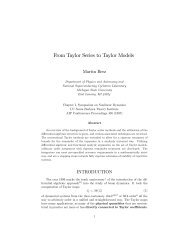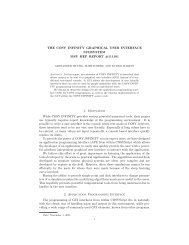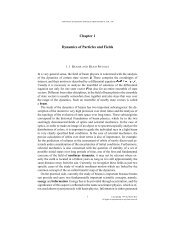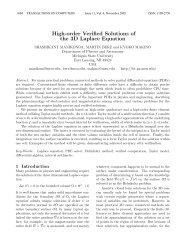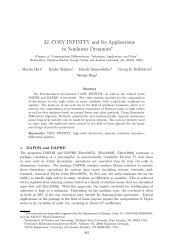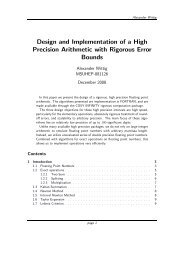Analytical Properties of Power Series on Levi-Civita Fields 1 ...
Analytical Properties of Power Series on Levi-Civita Fields 1 ...
Analytical Properties of Power Series on Levi-Civita Fields 1 ...
Create successful ePaper yourself
Turn your PDF publications into a flip-book with our unique Google optimized e-Paper software.
K. Shamseddine and M. Berz<br />
the double sum ∑ ∞<br />
k=1<br />
∑ ∞<br />
j=1 (a kjh j ) [q] c<strong>on</strong>verges; so we can interchange the<br />
order <str<strong>on</strong>g>of</str<strong>on</strong>g> the summati<strong>on</strong>s (see for example [11] pp 205-208) and obtain that<br />
((g ◦ f) (x + h)) [q] = ((g ◦ f) (x)) [q] +<br />
for all q ∈ Q. Therefore,<br />
(g ◦ f) (x + h) = (g ◦ f) (x) +<br />
= ((g ◦ f) (x)) [q] +<br />
∞∑<br />
k=1 j=1<br />
∞∑<br />
k=1 j=1<br />
∞∑<br />
j=1 k=1<br />
∞∑<br />
a kj h j = (g ◦ f) (x) +<br />
∞∑ (<br />
akj h j) [q]<br />
∞∑ (<br />
akj h j) [q]<br />
∞∑<br />
j=1 k=1<br />
∞∑<br />
a kj h j .<br />
Thus, rearranging and regrouping the terms in Equati<strong>on</strong> (4.1), we obtain that<br />
(g ◦ f) (x + h) = (g ◦ f) (x) + ∑ ∞<br />
j=1 c jh j , where the sequence (c j ) is regular.<br />
Just as we did in generalizing Lemma 4.3 to Corollary 4.4, we can now<br />
generalize Lemma 4.5 to infinitely small and infinitely large domains and<br />
obtain the following result.<br />
Corollary 4.6: Let a < b and c < e in R be given. Let f : [a, b] → R be R-<br />
analytic <strong>on</strong> [a, b], let g : [c, e] → R be R-analytic <strong>on</strong> [c, e], and let f ([a, b]) ⊂<br />
[c, e]. Then g ◦ f is R-analytic <strong>on</strong> [a, b].<br />
Pro<str<strong>on</strong>g>of</str<strong>on</strong>g>: Let t = λ(b − a) and j = λ(e − c); and let F : [d −t a, d −t b] → R<br />
and G : [d −j c, d −j e] → R be given by<br />
F (x) = d −j f ( d t x ) and G(x) = g ( d j x ) .<br />
Then F and G are R-analytic <strong>on</strong> [d −t a, d −t b] and [d −j c, d −j e], respectively;<br />
moreover, F ([d −t a, d −t b]) ⊂ [d −j c, d −j e]. Since [d −t a, d −t b] and [d −j c, d −j e]<br />
both have finite lengths, by our choice <str<strong>on</strong>g>of</str<strong>on</strong>g> t and j, we obtain by Lemma 4.5<br />
that G ◦ F is R-analytic <strong>on</strong> [d −t a, d −t b]. But for all x ∈ [d −t a, d −t b], we have<br />
that<br />
G ◦ F (x) = G (F (x)) = G ( d −j f ( d t x )) = g ( f ( d t x )) = g ◦ f ( d t x ) .<br />
Since G ◦ F is R-analytic <strong>on</strong> [d −t a, d −t b], it follows that g ◦ f is R-analytic<br />
<strong>on</strong> [a, b].<br />
16



